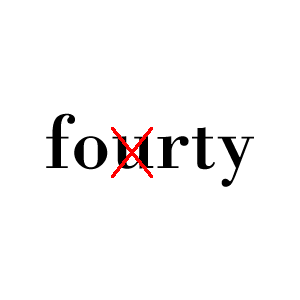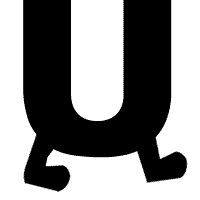 The simple answer to this posts question is:
The simple answer to this posts question is:
Nobody knows! It just vanished.
With four and fourteen, the u is there. When you get to forty, something strange happens. The u from earlier numbers in this sequence vanishes.
This is something that happened in the 18th century. You have to wade through the different spellings over the centuries. Sometimes a v, or other random letters, appears and vanishes a couple of decades later. One of the problems of a language that doesn’t have a controlling body.
Now according to the OED, the main definition of the word is:
The cardinal number equal to four tens, represented by the symbol 40 or xl. Also in comb. with numbers below ten (ordinal or cardinal) as forty-one, forty-first, etc.
We knew that anyway.
Now, if you look at oed.com, the definition goes onto its etymology. On other words, how the word has been used since it was first discovered in print. Forty is one of the older ones. Old-Saxon in origin [unusually, it’s not one of the “rude” ones!]. Our first recorded use is in around 950ad. It was used in the Lindisfarne gospels. Spelt as feuorig and then later in the sentence as feowertig” – spelling was never consistent until well into the 18th/19th century [I just can’t remember & my lack of research is showing]. Understandable as the word we still use today.
If we jump forward the best part of a thousand years to 1803. We have to skip some spellings such as vorty and fourtie. That last one made me smile – I just wish that spelling still existed.
The u disappeared briefly at the end of the 17th century, 1698, but then reappeared in 1707. That was the last time it was in the language.
Our first reference for the lack of U can be traced back quite a while to when the f became a v. This period of the word lost the u as well. A lot of time, the differences in spellings can indicate how the word was pronounced. forty would be pronounced differently to vorty.
The change of spelling, not of use as that has been consistent since the 10th century, has been tracked down to a paper to the Royal Society in 1803 “It… was found to contain one forty-eighth of antimony“. The later has been missing since then. It may re-appear in the future as it has done in the past.
Yes, the English language has the OED. The keepers of the language. They don’t prescribe the language but mealy describe it.
They would prefer you to spell a word one way but if you don’t then you’re still corroct 🙂
The English language has always been in flux. From Anglo Saxon days to the present day. Changes happen all the time. Even the short time between Chaucer and Shakespeare. One is readable, the other needs copious footnotes to understand what he’s writing. The period of the Great Vowel Shift. The period that middle/old English became modern English.
 By 1803, that pesky u was finally assigned to the bin of spellings. Nothing to do with the spelling reform people. The people who have tried over the centuries to make English more consistent. Removing the silent letters from words like doubt. Sometimes inventing new letters! Good intentioned fiddles that did nothing to the language apart from messing. Webster did it in America with the removal of the U in words like colour. Making endings easier to remember such as center and theater. The things that can annoy the British as we think it’s wrong. It maybe for us, currently, but give it time and we may lose letters from other words. Silent letters would be a good start.
By 1803, that pesky u was finally assigned to the bin of spellings. Nothing to do with the spelling reform people. The people who have tried over the centuries to make English more consistent. Removing the silent letters from words like doubt. Sometimes inventing new letters! Good intentioned fiddles that did nothing to the language apart from messing. Webster did it in America with the removal of the U in words like colour. Making endings easier to remember such as center and theater. The things that can annoy the British as we think it’s wrong. It maybe for us, currently, but give it time and we may lose letters from other words. Silent letters would be a good start.












